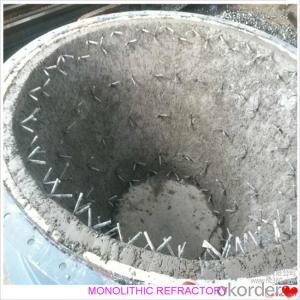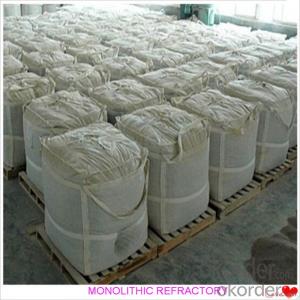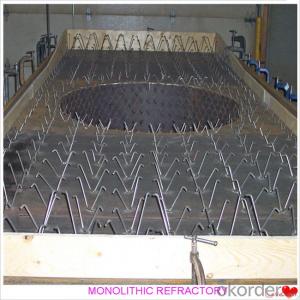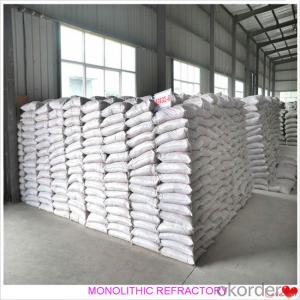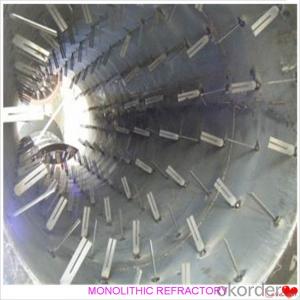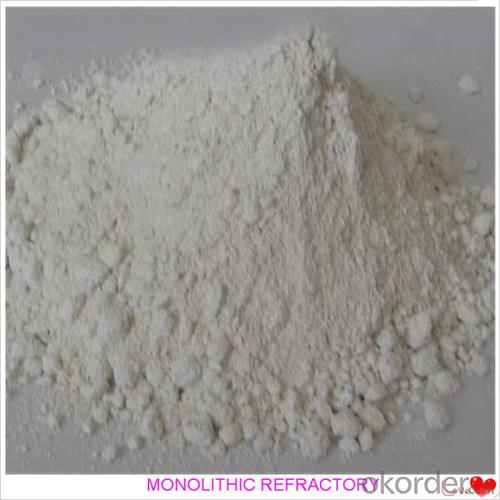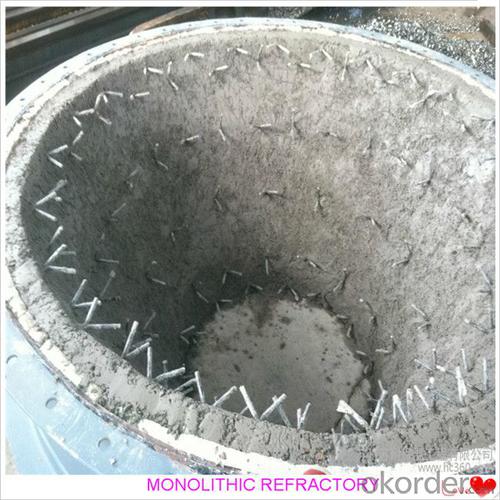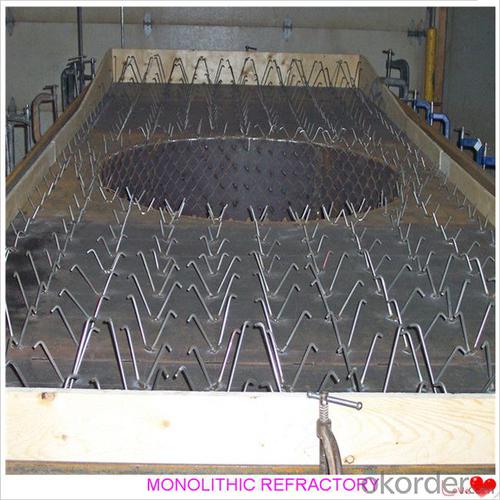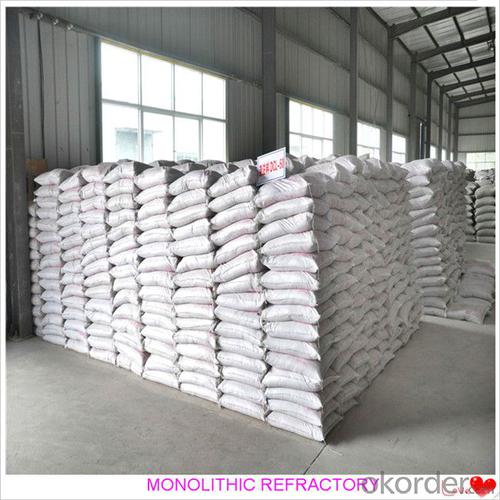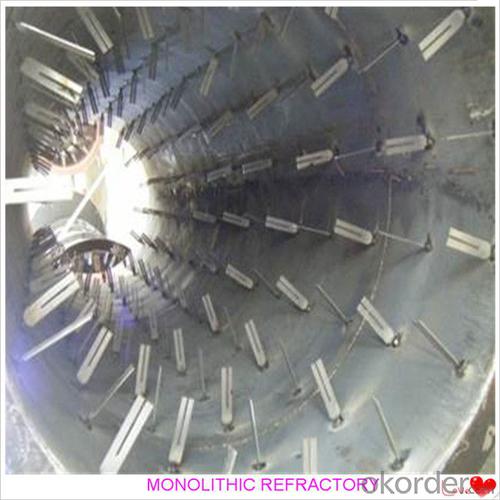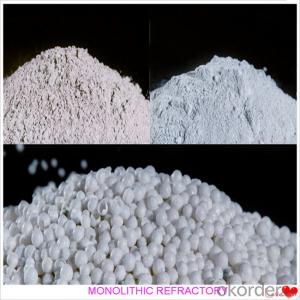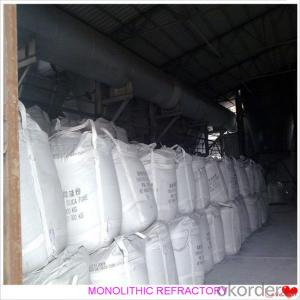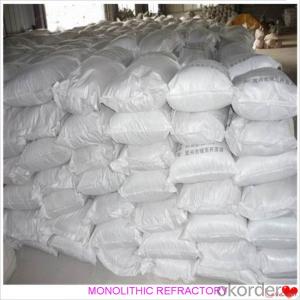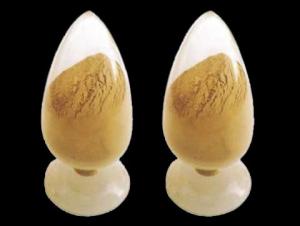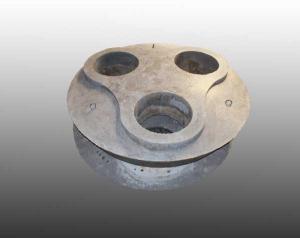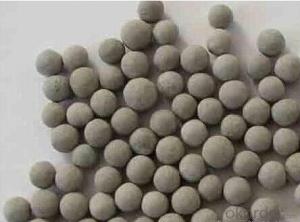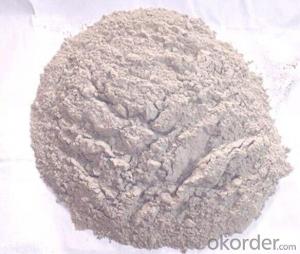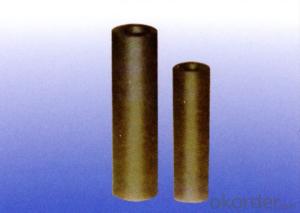Monolithic Refractories for Iron and Steel Industry:Refractory Castable for Fireplace and Industrial Furnace
- Loading Port:
- China main port
- Payment Terms:
- TT or LC
- Min Order Qty:
- 1000 kg
- Supply Capability:
- 3000000 kg/month
OKorder Service Pledge
OKorder Financial Service
You Might Also Like
Refractory Castable for Fireplaces and Industrial Furnaces
Product Description:
Gunning castable is manufactured according to international standards. The product is famous for its excellent abrasion resistance and low thermal conductivity. Further, these can be provided in different specifications as required by clients. Gunning castables use high purity raw materials and additives as the main material, and are made with superfine powder adding technology.
Product Features:
The material has excellent structural stability and air tightness, and has high physical and chemical properties, and also excellent working ability. If should be used with the same material products.
Product Applications:
Widely used in various kiln linings, such as boilers, blast furnace hot blast stoves, heating furnaces, ceramic kilns, heat treatment furnaces, incinerators, re-circulating fluidized bed furnaces and chemical industry and construction industry furnaces.
Product Specifications:
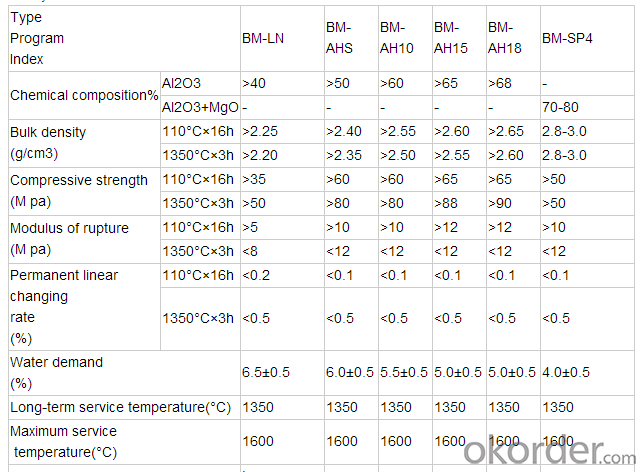
Product Images:
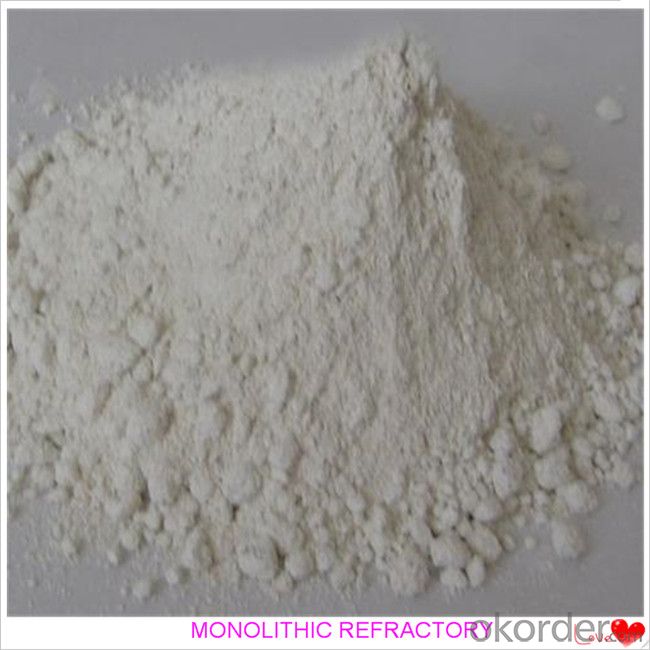
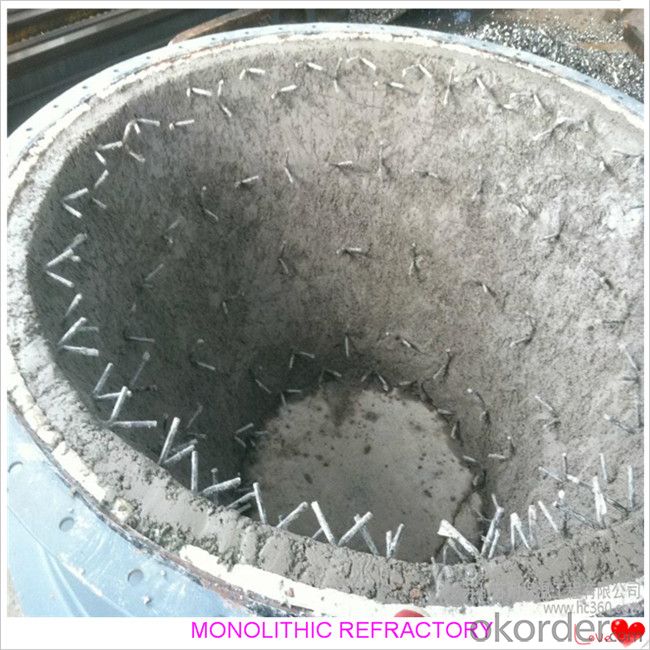
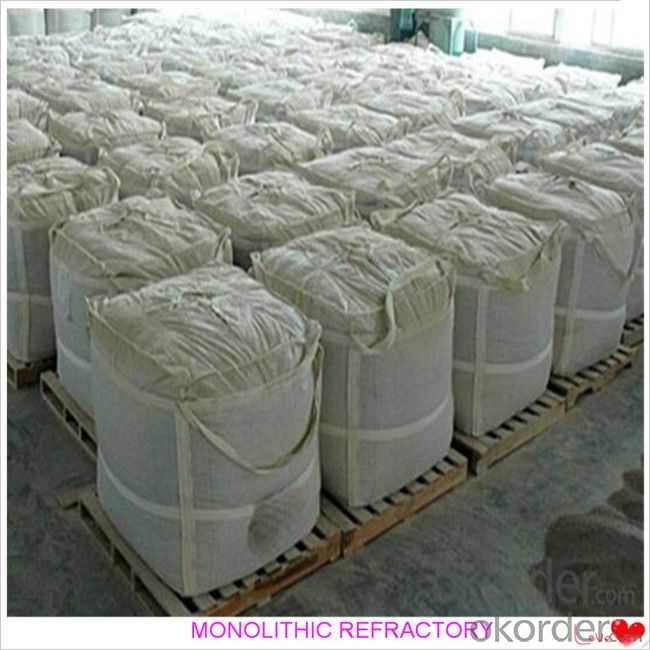
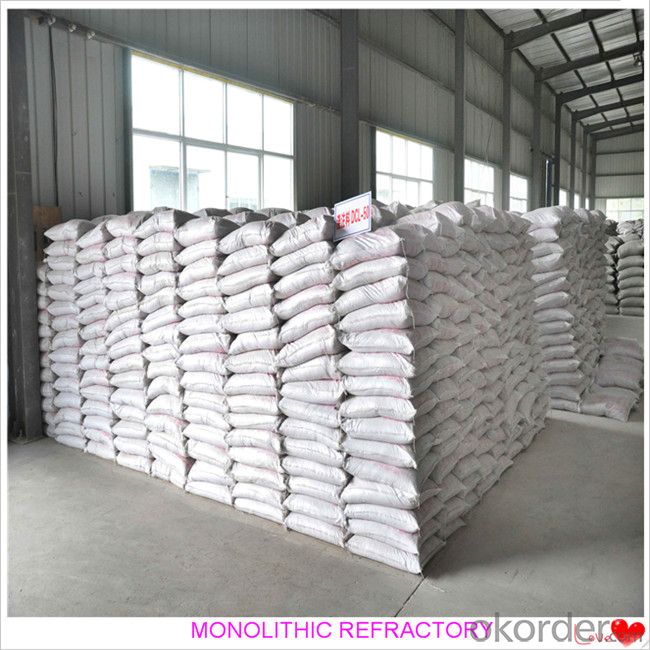
FAQ:
Q1: Why buy Materials & Equipment from OKorder.com?
A1: All products offered by OKorder.com are carefully selected from China's most reliable manufacturing enterprises. Through its ISO certifications, OKorder.com adheres to the highest standards and a commitment to supply chain safety and customer satisfaction.
Q2: How do we guarantee the quality of our products?
A2: We have established an advanced quality management system which conducts strict quality tests at every step, from raw materials to the final product. At the same time, we provide extensive follow-up service assurances as required.
Q3: What are Abrasion Resistant Coatings?
A3: ARC's abrasion resistant coatings guard against the severe wear and erosion that can chip away your plant's bottom line. These high-performance coatings protect new equipment as well as rebuild worn equipment at a fraction of traditional replacement costs.
- Q: What are the recent developments in monolithic refractories for the iron and steel industry?
- Recent developments in monolithic refractories for the iron and steel industry include advancements in material composition, manufacturing techniques, and application methods. These developments have led to improved refractory performance, enhanced durability, and increased energy efficiency. Some notable developments include the use of new raw materials, such as nano-sized additives and ultra-high temperature-resistant binders, which enhance the refractory's resistance to thermal shock and corrosion. Additionally, advancements in manufacturing techniques, such as advanced mixing technologies and precise curing processes, have resulted in more homogenous and consistent refractory structures. Furthermore, there have been innovations in application methods, including the use of robotic systems for precise and efficient installation, leading to reduced downtime and increased productivity in the iron and steel industry. Overall, these recent developments in monolithic refractories have significantly contributed to the optimization of iron and steel production processes.
- Q: How are monolithic refractories recycled or disposed of at the end of their lifespan?
- Monolithic refractories, which are commonly used in high-temperature industrial applications, can be recycled or disposed of at the end of their lifespan through several methods. The chosen method depends on the specific type of monolithic refractory and its composition. One common approach to recycling monolithic refractories is through a process known as reclamation. Reclamation involves collecting used refractory materials and processing them to remove any impurities or contaminants. The reclaimed refractory material can then be crushed, ground, or milled to produce a fine powder that can be used as a raw material in the production of new refractories. Another method of recycling monolithic refractories is through thermal treatment. This involves subjecting the used refractory material to high temperatures in a controlled environment, such as a kiln or furnace. The heat helps to break down the refractory material, removing any binders or impurities. The resulting material can then be reused as a raw material or incorporated into other applications, such as aggregates for construction. In cases where recycling is not feasible, monolithic refractories can be disposed of in specialized facilities designed for handling and treating hazardous waste. These facilities ensure that the refractory material is properly contained and treated to minimize any potential environmental impact. This disposal method is typically used for refractories that contain hazardous substances or cannot be recycled due to their composition. It is important to note that the proper disposal or recycling method for monolithic refractories should comply with local regulations and guidelines. These regulations aim to ensure the safe handling, treatment, and disposal of these materials, taking into consideration their potential environmental and health impacts. Therefore, it is crucial for industries and businesses to work closely with waste management professionals and follow the appropriate procedures to responsibly manage monolithic refractories at the end of their lifespan.
- Q: What are the challenges in recycling monolithic refractories?
- There are several challenges in recycling monolithic refractories that make the process more complex compared to other materials. Firstly, monolithic refractories are designed to withstand high temperatures and harsh conditions, making them highly resistant to wear and tear. This durability also poses a challenge in the recycling process, as it requires specialized techniques and equipment to break down and separate the refractory material. Secondly, monolithic refractories often contain various additives and binders, such as clay, cement, and other organic compounds, which can complicate the recycling process. These additives may need to be removed or separated from the refractory material before it can be recycled effectively. Additionally, monolithic refractories can be contaminated with other materials, such as metal oxides, slag, and impurities, during their service life. These contaminants can affect the quality and properties of the recycled refractory material, requiring thorough cleaning and purification processes. Moreover, the logistics involved in collecting and transporting monolithic refractories for recycling can be challenging. Refractories are often used in large quantities in industrial settings, and their removal and transportation can be costly and time-consuming. Furthermore, finding suitable recycling facilities with the necessary equipment and expertise to handle monolithic refractories can be limited, especially in certain regions. Lastly, economic factors play a role in the challenges of recycling monolithic refractories. The cost of recycling and processing the refractories may not always be financially viable compared to using virgin materials. This can discourage companies from investing in recycling programs and contribute to the lower demand for recycled refractory materials. Overall, the challenges in recycling monolithic refractories mainly stem from their durability, complex composition, contamination, logistics, and economic considerations. However, advancements in technology and increased awareness of the environmental benefits of recycling may help overcome these challenges and promote the sustainable reuse of refractory materials.
- Q: How are monolithic refractories used in the repair and maintenance of ladles and tundishes?
- Monolithic refractories are extensively used in the repair and maintenance of ladles and tundishes in the steel industry. These refractories are specially designed to withstand the extreme conditions of high temperatures, thermal shock, and chemical erosion that occur during the steelmaking process. When it comes to the repair of ladles, monolithic refractories are used to line the inner walls of the ladle. Ladles are subjected to intense heat and corrosive molten metal, and the refractory lining provides insulation and protection against these harsh conditions. The lining also helps to maintain the desired temperature of the molten metal, ensuring that it remains in a suitable state for processing. In the case of tundishes, monolithic refractories are used to line the bottom and sides of the tundish, as well as the nozzle and impact pad. Tundishes are responsible for distributing molten metal to multiple casting molds and are exposed to high temperatures and thermal shocks. The refractory lining helps to maintain the necessary temperature and prevent any leakage of molten metal. During the repair and maintenance process, monolithic refractories are applied as a dense, high-strength material that is easy to shape and install. They can be shaped into various forms such as bricks, castables, and gunning mixes, depending on the specific requirements of the ladle or tundish. These refractories are often applied using specialized techniques, such as gunning or casting, to ensure proper adhesion and longevity. In addition to their thermal and chemical resistance properties, monolithic refractories also offer excellent mechanical strength and resistance to abrasion. This is crucial in ladles and tundishes, as they are subjected to constant wear and tear from the movement of molten metal and the handling of refractory materials during repair and maintenance. Overall, monolithic refractories play a critical role in the repair and maintenance of ladles and tundishes in the steel industry. They provide the necessary insulation, protection, and durability required to withstand the demanding conditions of steelmaking.
- Q: What are the different types of monolithic refractories used in the iron and steel industry?
- There are several types of monolithic refractories used in the iron and steel industry, including castables, ramming mixes, gunning mixes, and plastic refractories. Castables are a mixture of refractory aggregates, binders, and additives that can be poured and shaped into various forms. Ramming mixes are granular refractories that can be packed and tamped into place using a ramming tool. Gunning mixes are similar to ramming mixes but are applied using a gunning machine. Plastic refractories are moldable materials that can be shaped and installed by hand. These different types of monolithic refractories offer flexibility and ease of installation in various applications within the iron and steel industry.
- Q: How do monolithic refractories resist chemical attack from molten metals and slags?
- Monolithic refractories are designed to resist chemical attack from molten metals and slags through a combination of factors. Firstly, monolithic refractories are typically made from high-quality materials that have excellent chemical resistance properties. These materials, such as alumina, magnesia, or silica, have a stable chemical structure that can withstand the corrosive nature of molten metals and slags. Secondly, monolithic refractories are often formulated with additives or binders that enhance their resistance to chemical attack. These additives can improve the refractory's ability to form a protective layer on its surface, which acts as a barrier between the refractory material and the corrosive molten metal or slag. Additionally, monolithic refractories are often designed with a dense microstructure that limits the penetration of molten metals and slags. The dense structure minimizes the pathways through which corrosive agents can reach the refractory material, reducing the risk of chemical attack. Moreover, monolithic refractories can be installed with proper joint design and anchoring systems to prevent the infiltration of corrosive substances. This ensures that the refractory lining remains intact and effectively resists chemical attack. Overall, the combination of high-quality materials, additives, dense microstructure, and proper installation techniques contribute to the ability of monolithic refractories to resist chemical attack from molten metals and slags, thereby extending their lifespan and maintaining the integrity of the refractory lining in high-temperature applications.
- Q: What are monolithic refractories?
- Monolithic refractories, in contrast to individual bricks or precast shapes, are refractory materials that are manufactured as a single unit. They can be shaped and installed without the need for joints or mortar, making them convenient for lining furnaces, boilers, kilns, and other high-temperature industrial equipment. These refractories consist of a carefully selected mixture of refractory aggregates, binders, and additives. This combination provides desired properties such as high temperature resistance, thermal shock resistance, and chemical durability. Aggregates like alumina, magnesia, zirconia, and silica are used, while binders such as clay, cement, or phosphate hold the aggregates together. One advantage of monolithic refractories is their ability to adapt to complex shapes and designs, allowing for customized linings that meet specific equipment requirements. They can be applied through pouring, gunning, ramming, or spraying onto the surface to be lined, leading to quick and efficient installation. This eliminates the need for time-consuming bricklaying and jointing, reducing installation time and labor costs. Monolithic refractories also possess superior thermal conductivity, enabling them to withstand high temperatures and sudden temperature changes. They offer excellent insulation properties, preventing heat loss and improving energy efficiency in industrial processes. Additionally, these refractories exhibit good resistance to chemical attack from molten metals, slags, gases, and other corrosive substances found in various industrial environments. This makes them highly suitable for applications in steel, cement, glass, petrochemical, and non-ferrous metals industries. In conclusion, monolithic refractories are a versatile and efficient solution for high-temperature applications. Their ability to be shaped and installed without joints or mortar, combined with their excellent thermal conductivity and chemical resistance, make them a valuable choice for lining industrial equipment operating under extreme conditions.
- Q: What are the main factors affecting the abrasion resistance of monolithic refractories?
- The main factors affecting the abrasion resistance of monolithic refractories can be categorized into three key aspects: material composition, microstructure, and service conditions. Firstly, material composition plays a crucial role in determining the abrasion resistance of monolithic refractories. The choice of raw materials, such as aggregates and binders, directly influences the overall hardness, strength, and wear resistance of the refractory. For instance, high-alumina refractories, which contain a high percentage of alumina as the main component, tend to exhibit excellent abrasion resistance due to the hardness and toughness of alumina. Conversely, refractories with a high proportion of softer materials like clay or magnesia may have lower abrasion resistance. Secondly, the microstructure of monolithic refractories greatly affects their ability to withstand abrasion. The distribution and orientation of aggregates, as well as the bond strength between the particles and the matrix, play significant roles in determining the resistance to wear. A well-distributed and interconnected network of aggregates can enhance the refractory's strength and resistance to abrasion. Additionally, a dense and well-sintered matrix can inhibit the penetration of abrasive particles, thereby reducing wear. Lastly, the service conditions in which the monolithic refractories are exposed to are crucial factors in determining their abrasion resistance. Factors such as temperature, atmosphere, and mechanical stress can significantly impact the wear behavior of refractories. High temperatures can cause thermal expansion and contraction, leading to cracks and spalling, which can accelerate abrasion. The presence of corrosive gases or chemicals can also deteriorate the refractory's microstructure, reducing its resistance to wear. Furthermore, mechanical stress from impact or friction can cause localized wear and damage the refractory. In conclusion, the main factors affecting the abrasion resistance of monolithic refractories include material composition, microstructure, and service conditions. By carefully selecting the appropriate raw materials, optimizing the microstructure, and considering the specific service conditions, it is possible to enhance the abrasion resistance of monolithic refractories and improve their overall performance in high-wear applications.
- Q: How do monolithic refractories contribute to the safety of iron and steel plants?
- Monolithic refractories play a crucial role in ensuring the safety of iron and steel plants. These refractories are specially designed to withstand high temperatures, chemical attacks, and mechanical stresses commonly encountered in these industrial settings. By utilizing monolithic refractories, iron and steel plants can benefit in the following ways: 1. Thermal resistance: Monolithic refractories have excellent resistance to extreme temperatures, preventing heat loss and ensuring the efficient operation of various equipment and systems. This thermal insulation contributes to the safety of the plant by reducing the risk of overheating, which could lead to equipment failure or even catastrophic accidents. 2. Chemical resistance: Iron and steel plants involve the use of various chemicals, including molten metal, slag, and corrosive gases. Monolithic refractories exhibit high resistance to these aggressive chemical environments, preventing corrosion, erosion, and material degradation. This resistance ensures the integrity of refractory linings, reducing the risk of leaks, spills, and contamination that could jeopardize the safety of workers and the environment. 3. Structural stability: Monolithic refractories provide excellent mechanical strength, offering structural stability to the linings of furnaces, ladles, and other equipment. This stability is crucial for the safe operation of iron and steel plants, as it minimizes the risk of structural failure, collapse, or damage caused by mechanical stresses or heavy loads. 4. Rapid repair and maintenance: Monolithic refractories offer the advantage of easy installation and repair compared to traditional brick refractories. Their application involves pouring, gunning, or ramming the refractory material in place, which allows for quick repairs and maintenance. This rapid response to refractory failures or damages contributes to the plant's safety by minimizing downtime and preventing potential hazards associated with equipment malfunction. 5. Flexibility and adaptability: Monolithic refractories can be tailored to meet the specific needs and requirements of iron and steel plants. They can be customized in terms of composition, density, thermal conductivity, and other properties, allowing for optimal performance under varying operating conditions. This adaptability ensures that refractory linings are well-suited for the plant's processes, reducing the likelihood of accidents or incidents caused by inadequate refractory materials. In summary, monolithic refractories enhance the safety of iron and steel plants by providing thermal resistance, chemical resistance, structural stability, rapid repair capabilities, and flexibility. By utilizing these refractories, iron and steel plants can maintain a safe working environment, minimize the risk of accidents, and ensure the reliable operation of their equipment and systems.
- Q: What are the considerations for selecting monolithic refractories for reheating furnaces?
- When selecting monolithic refractories for reheating furnaces, there are several important considerations to take into account. 1. Temperature requirements: Reheating furnaces operate at high temperatures, so it is crucial to choose monolithic refractories that can withstand the desired temperature range without experiencing significant thermal degradation or failure. The refractories must have a high refractoriness to maintain their structural integrity under these conditions. 2. Thermal shock resistance: Reheating furnaces often undergo rapid temperature changes due to the heating and cooling cycles. Monolithic refractories with good thermal shock resistance are essential to prevent cracking and spalling, which can lead to premature failure of the lining. 3. Mechanical strength: The monolithic refractories should have sufficient mechanical strength to withstand the stresses induced by the weight of the materials being heated and any mechanical movements within the furnace. This helps to prevent deformation or structural failure of the refractory lining. 4. Chemical compatibility: The refractories must be chemically compatible with the atmosphere and process gases present in the reheating furnace. They should resist chemical attacks from the gases or any corrosive substances generated during the reheating process. This ensures a longer service life for the refractory lining. 5. Abrasion resistance: Reheating furnaces often handle abrasive materials, such as hot billets or slabs. Selecting monolithic refractories with good abrasion resistance will help to minimize wear and extend the lifespan of the lining. 6. Ease of installation: Monolithic refractories offer advantages in terms of ease of installation compared to traditional brick refractories. However, it is important to consider the installation method and time required for the chosen monolithic refractory. Some monolithic refractories may require specialized equipment or techniques for installation. 7. Cost-effectiveness: While the initial cost of monolithic refractories may be higher than traditional brick refractories, their longer service life and ease of installation can result in overall cost savings. Assessing the cost-effectiveness of different monolithic refractory options is crucial for selecting the most suitable one for the reheating furnace. By considering these factors, one can make an informed decision when selecting monolithic refractories for reheating furnaces, ensuring optimal performance, durability, and cost-effectiveness.
Send your message to us
Monolithic Refractories for Iron and Steel Industry:Refractory Castable for Fireplace and Industrial Furnace
- Loading Port:
- China main port
- Payment Terms:
- TT or LC
- Min Order Qty:
- 1000 kg
- Supply Capability:
- 3000000 kg/month
OKorder Service Pledge
OKorder Financial Service
Similar products
Hot products
Hot Searches
Related keywords

